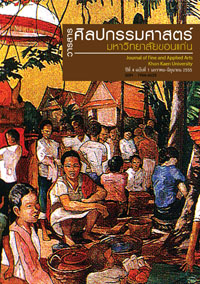การพัฒนานวัตกรรมการสอนวิชานาฏศิลป์ เรื่อง นาฏลีลานาฏยศัพท์
Main Article Content
Abstract
การวิจัยนี้ผู้วิจัยได้พัฒนานวัตกรรมการสอนวิชานาฏศิลป์เรื่องนาฏลีลานาฏยศัพท์ ซึ่งจุดเด่นของนวัตกรรมนี้ เป็นการฝึกปฏิบัตินาฏยศัพท์ของนาฏศิลป์ไทย (ละคร)แต่ละคำด้วยเพลงที่มีเนื้อเพลงเป็นกลอนสุภาพมีสัมผัสคล้องจอง ได้ความหมาย แต่ละเพลงขับร้อง และบรรเลงด้วยวงปี่พาทย์โดยใช้ทำนองเพลงไทยที่ไพเราะคุ้นหู อันจะช่วยให้ผู้เรียนเกิดทักษะเพราะได้ปฏิบัตินาฏยศัพท์แต่ละคำซํ้าๆ และได้รับความเพลิดเพลินด้วยเสียงเพลงขณะปฏิบัติ ดังนั้นการวิจัยนี้จึงมุ่งศึกษาประสิทธิภาพของนวัตกรรม “นาฏลีลานาฏยศัพท์” โดยใช้วิธีสอนปฏิบัตินาฏศิลป์ตามแนวคิดการพัฒนาทักษะปฏิบัติของซิมพ์ซัน(Sympson) สำหรับนักศึกษาสาขาวิชานาฏศิลป์และการละคร และสาขาวิชานาฏดุริยางคศิลป์ไทย มหาวิทยาลัยราชภัฏราชนครินทร์ ที่มีประสิทธิภาพตามเกณฑ์มาตรฐาน 80/80 เปรียบเทียบคะแนนก่อนและหลังการเรียนจากการใช้นวัตกรรมการสอน และศึกษาความพึงพอใจของนักศึกษาที่มีต่อนวัตกรรมการสอนวิชานาฏศิลป์เรื่องนาฏลีลานาฏยศัพท์ กลุ่มประชากรที่ใช้ในการวิจัยครั้งนี้ ได้แก่ นักศึกษาสาขาวิชานาฏศิลป์การละคร 3 กลุ่ม 3 ชั้นปีและสาขาวิชานาฏดุริยางคศิลป์ไทย 2 กลุ่ม 2 ชั้นปี จำนวนทั้งสิ้น 33 คน เครื่องมือที่ใช้ในการวิจัยครั้งนี้ ได้แก่ นวัตกรรมการสอนวิชานาฏศิลป์ เรื่อง นาฏลีลานาฏยศัพท์ แบบทดสอบวัดผลสัมฤทธิ์ทางการเรียน แบบประเมินทักษะปฏิบัติทางนาฏศิลป์ และแบบสอบถามความความพึงพอใจของนักศึกษา การวิเคราะห์ข้อมูลที่ได้ใช้วิธีหาค่าเฉลี่ย ส่วนเบี่ยงเบนมาตรฐานและร้อยละ ใช้สถิติทดสอบสมมติฐานคือ เปรียบเทียบผลสัมฤทธิ์ทางการเรียนของนักศึกษาที่เรียนโดยนวัตกรรมการสอนวิชานาฏศิลป์ เรื่อง นาฏลีลานาฏยศัพท์ โดยการทดสอบค่าที (t-test for Dependent Samples) เปรียบเทียบทักษะการปฏิบัตินาฏศิลป์โดยวิธีสอนปฏิบัตินาฏศิลป์ตามแนวคิดพัฒนาทักษะปฏิบัติของซิมพ์ซันโดยการทดสอบค่าที (Single Samplet - test)
ผลวิจัยพบว่า
1. ประสิทธิภาพของนวัตกรรมทางการสอนนาฏศิลป์ เรื่อง นาฏลีลานาฏยศัพท์ ที่สร้างขึ้นมีประสิทธิภาพด้านกระบวนการ และด้านผลลัพธ์เท่ากับ 81.92/91.36 สูงกว่าเกณฑ์มาตรฐาน 80/80 ที่ตั้งไว้
สำหรับดัชนีประสิทธิผลของนวัตกรรมทางการสอนนาฏศิลป์ เรื่อง นาฏลีลานาฏยศัพท์ ที่สร้างขึ้นมีค่าเท่ากับ 0.7230 แสดงว่า หลังจากการใช้นวัตกรรมทางการสอน นักศึกษามีคะแนนเพิ่มขึ้นคิดเป็นร้อยละ 72.30
2. ผลสัมฤทธิ์ทางการเรียนของนักศึกษาสาขาวิชานาฏศิลป์และการละครและสาขาวิชานาฏดุริยางคศิลป์ไทย มหาวิทยาลัยราชภัฏราชนครินทร์ ที่เรียนโดยนวัตกรรมการสอนวิชานาฏศิลป์ เรื่อง นาฏลีลานาฏยศัพท์ พบว่ามี คะแนนการทดสอบวัดผลสัมฤทธิ์ทางการเรียนหลังเรียนสูงกว่าก่อนเรียนอย่างมีนัยสำคัญทางสถิติที่ระดับ .05
3. นักศึกษาที่เรียนโดยวิธีสอนปฏิบัตินาฏศิลป์ตามแนวคิดพัฒนาทักษะปฏิบัติของซิมพ์ซัน มีทักษะการปฏิบัตินาฏศิลป์ที่ใช้นวัตกรรมการสอนโดยรวมและรายเพลงทุกเพลง สูงกว่าเกณฑ์มาตรฐานร้อยละ 80 อย่างมีนัยสำคัญทางสถิติที่ระดับ .05
4. ความพึงพอใจของนักศึกษาสาขาวิชานาฏศิลป์และการละคร กับสาขา วิชานาฏดุริยางคศิลป์ไทย มหาวิทยาลัยราชภัฏราชนครินทร์ ที่มีต่อนวัตกรรมการสอนวิชานาฏศิลป์ เรื่อง นาฏลีลานาฏยศัพท์ เฉลี่ยโดยรวมอยู่ในระดับมาก เมื่อพิจารณาวิธีสอนปฏิบัตินาฏศิลป์ตามแนวคิดการพัฒนาทักษะการปฏิบัติของซิมพ์ซันโดยเรียงลำดับความพึงพอใจต่อขั้นการสอนจากมากไปน้อย พบว่า ขั้นที่ 7 ขั้นการคิดเริ่ม นักศึกษามีความพึงพอใจมากที่สุด รองลงมาได้แก่ ขั้นที่ 6 ขั้นการปรับปรุงและประยุกต์ใช้ ขั้นที่ 1 ขั้นการรับรู้ ขั้นที่ 3 ขั้นการสนองตอบภายใต้การควบคุม ขั้นที่ 5 ขั้นการกระทำอย่างชำนาญ ขั้นที่ 2 ขั้นเตรียม ความพร้อม และขั้นที่ 4 ขั้นการให้ลงมือกระทำจนกลายเป็นกลไกที่สามารถกระทำได้เอง ตามลำดับ
A Development of Teaching Innovation for Classical Performing Arts on Nataleela-natayasap
This research is aimed at developing the teaching innovation entitled Nataleela-natayasap. The main outstanding feature of this innovation is an emphasis on the practice of Thai classical dancing gestures (La Khon) regarding the interpretation of each word. The lyrics are composed with the Thai fixed-rhythmic verse. The composed songs, accompanied with Thai musical ensemble, are melodious and familiar as well as facilitating students for pleasure and giving opportunity to gain more skills while continuing practice. Therefore, this research is aimed to study the effectiveness of Nataleela-natayasap through Simpson’s skill development approach. The research was conducted on Thai students who studied in the program of Classical Performing Arts and Drama and that of Thai Music and Dramatic Arts at Rajabhat Rajanagarindra University (RRU). The research was to compare students’ scores before and after the application of the innovation and to investigate the students’ satisfaction levels towards it. The sample group consisted of 33 students: three groups from 1st-3rd year students in the program of Classical Performing Arts and Drama. Besides, the sample group covered two groups from 1st-2nd year students in the program of Thai Music and Dramatic Arts. The research instruments were the teaching innovation regarding Nataleela-natayasap, achievement test, skill-evaluation form for dancing arts, and questionnaire regarding students’ satisfaction. The data analysis was conducted through means, standard deviation and percentage. Also, to compare students’ achievement after application of the teaching innovation was conducted in this research through t-test for Dependent Samples and Single Sample t-test for comparing students’ performance skills through Simpson’s skill-development approach. The results revealed that
1. The efficiency of the teaching innovation on Nataleela-natayasab showed that students’ scores during the studying session were 81.92%. After the application of the teaching innovation, their scores were 91.36%. Obviously, the efficiency of process and that of outcome were 81.92%/91.36%; it was higher than the expected 80/80 standard.
2. The efficiency index of the created teaching innovation was 0.7230%. It showed that the students’ scores had increased for 72.30%.
3. A comparison of achievement of RRU students majored in Dancing Arts and Drama and those of Thai Music and Dramatic Arts who studied through this teaching innovation showed that their posttest scores were higher than those of pretest ones at the level of significance of 0.05.
4. A comparison of the students’ skills for practical classical dancing after the application of Simpson’s skill development approach of RRU students, who studied in Thai Performing Arts and Drama and those of Thai Music and Dramatic Arts, showed that they were higher than the 80 percent standard at the 0.05 significant level.
5. Satisfaction of students of Thai Performing Arts and Drama and Thai Music and Dramatic Arts towards the teaching innovation was at high level. When considering the teaching method for Thai classical dance with Simpson’s skill development approach, it explicitly showed the level of students’ satisfaction in each level. The seventh level (origination) indicated that the students’ satisfaction was at highest level, the sixth level (adaptation), the first level (perception), the third level (guided response), the fifth level (complex overt response), the second level (preparation) and the fourth level (mechanism) were respectively ordered.
Article Details
Content and information in articles published in the Journal of Fine and Applied Arts of Khon Kaen University is regarded as the opinion and sole responsibility of the author(s) directly; therefore, editors are not obliged to agree to or share any responsibility with regard to the content and information that appears within these articles.
All articles, information, content, image, etc. that have been published in the Journal of Fine and Applied Arts of Khon Kaen University is the copyright of the Journal of Fine and Appllied Arts of Khon Kaen University. Any person or organization who wishes to distribute all or parts of the articles for further dissemination or other usage must first receive permission from the Journal of Fine and Applied Arts of Khon Kaen University before proceeding to do so.


